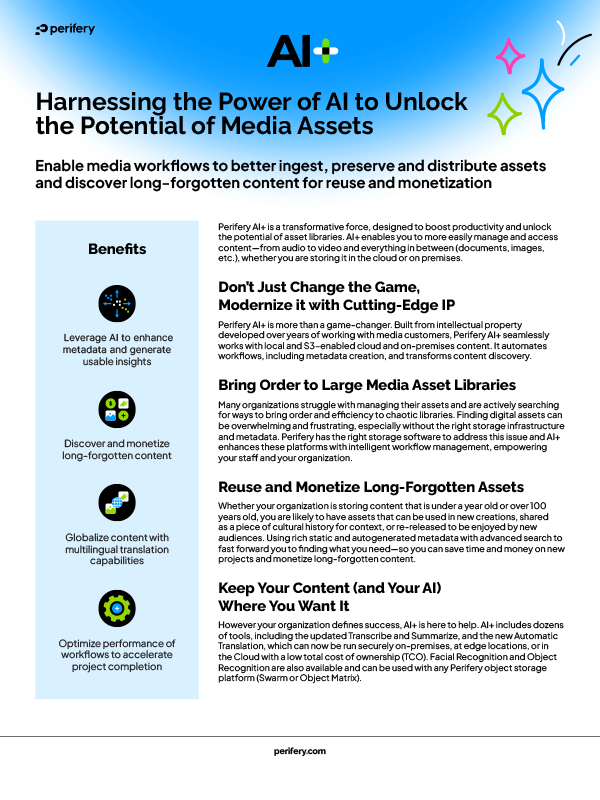Recap: Following successful testing, Perifery’s object storage solutions, Object Matrix and Swarm, are now available alongside Cinnafilm’s media transformation platform, PixelStrings. The integration allows users to seamlessly convert and upscale their media assets stored in Object Matrix within the PixelStrings platform.
Following the recent technology integration, Mark Habberfield, Senior Solutions Architect at Perifery, and Dom Jackson, VP of Product and Services at Cinnafilm, joined webinar host, Curtis Staples, Director of Customer Success and Marketing at Cinnafilm, to explore the partnership in more detail.
In this blog, we summarize the webinar, highlighting the benefits of each solution and exploring how they work together to transform how media is stored, accessed, and converted.
Introducing Perifery to the audience, Mark explained how the business unit came to light after several strategic acquisitions by parent company, DataCore. Sharing that each brand in the Perifery unit comes with more than 20 years’ worth of storage technology, Mark said, “It's a product stack that's been born out of years of development, talking to our customers, providing solutions for our customers... Perifery is really built for the next generation of media and entertainment workflows.”
Built specifically for M&E, and part of the Perifery tech stack, is the Object Matrix object storage solution. Accessible on-prem and in the cloud, Object Matrix supports both S3 and file system interfaces, making it compatible with different media workflows. Mark explained that one of its main features is ‘Process in Place’ - the ability to extract metadata. He elaborated, “Any media info, any camera metadata, anything that's passed through Adobe you see the XMP side of things, anything in the CPL files of IMFs and even AS-11/AS-10.“
Dom then introduced Cinnafilm, a company that has been offering innovative video and audio rejuvenation and optimization solutions in the M&E sector since 2007. Dom shared that in that time, Cinnafilm has attained three HPA Engineering Excellence Awards, and the technology is currently used by some of biggest names in the world of media. Dom described the company’s latest product offering, PixelStrings, as “a fully automated media processing platform.”
Available in the cloud as Software as a Service (SaaS) and on customers own infrastructure, the main use case for PixelStrings is content conversion and rejuvenation. Whether it's interlacing, noise reduction, scaling, frame rate and SDR-HDR conversion, or audio processing, PixelStrings combines advanced GPU accelerated processing with renowned technologies, such as Skywalker sound. He added, “we [also] integrate tightly with people like Perifery and Object Matrix to help customers automate their end-to-end workflows.”
Live Demonstration
To showcase the simplicity of using PixelStrings and Object Matrix together, Mark presented a demonstration in real-time, starting by setting up a job using PixelStrings to process content stored within Object Matrix. The demo highlighted the ease with which users can enhance and repurpose media content, generating high-quality results in a short amount of time.
- Setting Up Object Matrix: Users can set up buckets (or vaults) in Object Matrix, and view objects and metadata using Vision, with ease. Customizable storage options, metadata extraction, and secure access controls lay the foundation for efficient media organization and management.
- Connecting Object Matrix and PixelStrings: Mark established a seamless communication channel between the platforms, and demonstrated users' ability to configure endpoints, access keys, and parameters for a robust and secure connection. Although highly proficient navigating Object Matrix, Mark remarked how intuitive the PixelStrings interface was.
- Automated Processing with PixelStrings: Once connected, PixelStrings takes center stage in automating media processing. The demonstration showed how users can easily configure workflows, specify processing parameters, and define the output. Processing takes place in the background with a handy status bar to keep users up to date on progress.
Once the process was shown as complete in PixelStrings, Mark returned to the Vision interface to access the newly converted asset, stored in the Object Matrix bucket. The source file entered PixelStrings at 7.19mb and returned to Object Matrix at 53.6mb - in less than 15 minutes!
The webinar concluded with a Q&A session which elaborated on the workflow capabilities when using both Object Matrix and PixelStrings. Catch up on the webinar for the full experience.
